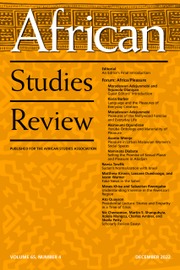Part of review forum on “A dam for Africa”
In this masterful study of society, science, and technology, Stephan Miescher scours the evidence for a rich, multivocal account of Kwame Nkrumah’s dream to bring a hydroelectric dam to West Africa. Miescher brings forward the accounts of all those caught up in this drama, what we might call the Big Men, the little people, the modern citizens, and the electric citizens.
First, Miescher tells a fine-grained story of how Kwame Nkrumah negotiated a lot of money with a collection of “Big Men” to create a dam to flood a vast area of land to make the largest lake people have ever created anywhere on earth. Miescher humanizes and dramatizes so many of these moments where powerful people casually negotiated massive deals.
At one point, the Minister of Finance, Komla Agbeli Gbedemah, was hoping to catch the ear of the president of the United States. While traveling in Maryland with African American friends, he decided to purposedly go to a typical restaurant where he was refused even juice, to create a media frenzy. Embarrassed, President Eisenhower and Vice President Nixon invited him to the White House where he discussed the plans for the Akosombo Dam over breakfast. Jealous of his rival’s proximity to the US President and Vice President, Nkrumah eventually sacked Gbedemah.
Another key moment, after the Kulungugu bomb attempt in August 1962 on Nkrumah’s life, he was surprisingly home alone on his birthday and also his self-proclaimed national holiday. With no one he could trust, the only guest he and his wife Fatima invited was Chad Calhoun, a representative from Kaiser, the American corporation that ended up negotiating the contract to use electricity from the Akosombo Dam to manufacture aluminum. Miescher describes how such interactions solidified the arrangement with Kaiser and shored up US support despite the deteriorating political situation in Ghana.
Miescher continues this semi-tragic retelling up to the point where Nkrumah appeared to kneel at the feet of his new imperialist overlords at a groundbreaking ceremony for the Valco project in 1964, a contrast to the image of Gbedemah with Eisenhower and Nixon in 1962. Then in 1966, Nkrumah opened the dam with Calhoun by his side, one month before losing political power in a coup d’état orchestrated in part with CIA alliances. Stephan argues how the terms of the original master plan for the Akosombo Dam were completely not in Ghana’s best interest and a classic example of the very neocolonialism that Nkrumah fought against.
The second thing that this book does brilliantly is juxtapose the official narratives about the resettlement plans for the 80,000 people living in the areas that the dam flooded with actual insights from those who lived through it. Because this is also how power works, those outside these international deal rooms, the “little people,” are also a part of the story and also make waves. As one of Stephan’s informants noted, no one wanted to see stories in the press of Ghanaians drowning for Nkrumah’s grand vision. Prior to the flooding, anthropologists and sociologists from Ghana’s new universities documented the histories and livelihoods of many of those who were affected and discussed resettlement plans with them.
But what Miescher does is go back and speak to people about their memories of relocation, and this is also the subject of a film he made with filmmaker Lane Clark as a companion to the book. People in the thriving cocoa town of Worobong and commercial center of Kete Krachi, for example, experienced what Stephan calls reverse modernization. They had farms, wealth, large homes, and then got downsized into poorly planned villages. The memories of people remain vivid, Janet Obenewaa described how as she escaped in a canoe from Worobong, “they noticed floating caskets washed out from the town’s grave, as well as antelopes, grasscutters, and snakes desperately trying to reach the shore.” Miescher goes on to discuss the differential experiences of men and women, the latter of whom tended to not be able to read and write and navigate the ensuing bureaucracy to receive state compensation.
The third arena Miescher’s book engages are the more successful planned communities at Akosombo and in the American island of Valco in Tema, the “modern citizens.” Miescher interrogates James Scott’s view that modernist state projects fail due to lack of engagement with local knowledge. In Miescher’s retelling of the Akosombo town at least, poorer residents argued and protested Greek architect C.A. Doxiadis’s initial plans, remaking the town into a hybrid design with their own interests in mind.
Similarly, while the Valco island by the coast was a purely neocolonial commercial venture that did not benefit the Ghanaian nation as a whole, Ghanaians working there enjoyed a better standard of life. They could purchase the latest American goods from the company catalogue. Their employment in a relatively progressive, inclusive company insulated them from some of Ghana’s financial woes after the fall of Nkrumah in the 1960s and 1970s. Over time, employees and government renegotiated the terms of the agreement with Valco to the point that it is now wholly Ghanaian owned.
Miescher ends the book with a meditation on efforts to extend electrification to rural areas and the urban areas that continue to experience dumsor (lights on lights off). He argues that getting access to electricity became the major way for Ghanaians to assert belonging in the new nation and their rights as “electric citizens.”


